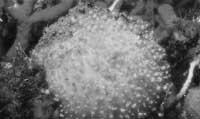Sponge fiber optic

Two groups of Italian researchers studying the skeleton of sponges in the cold seas claim that at the bottom of the Antarctic sea there are thousands of optical fibers. Two families of sponges have been analyzed, mainly sponges or silica.
These can be tens of centimeters long if they belong to the species Rossella racovitzb, located 120 meters deep. Laser tests have shown that the blades perfectly carry light to the body of the sponge.
In the body the small green algae called Ostreobium lives in symbiosis with the sponge, but the algae cannot live without daylight, and for it to have more light, the sponge itself has some type of solar catcher, small cross-shaped stools located at the end of the spicles.





